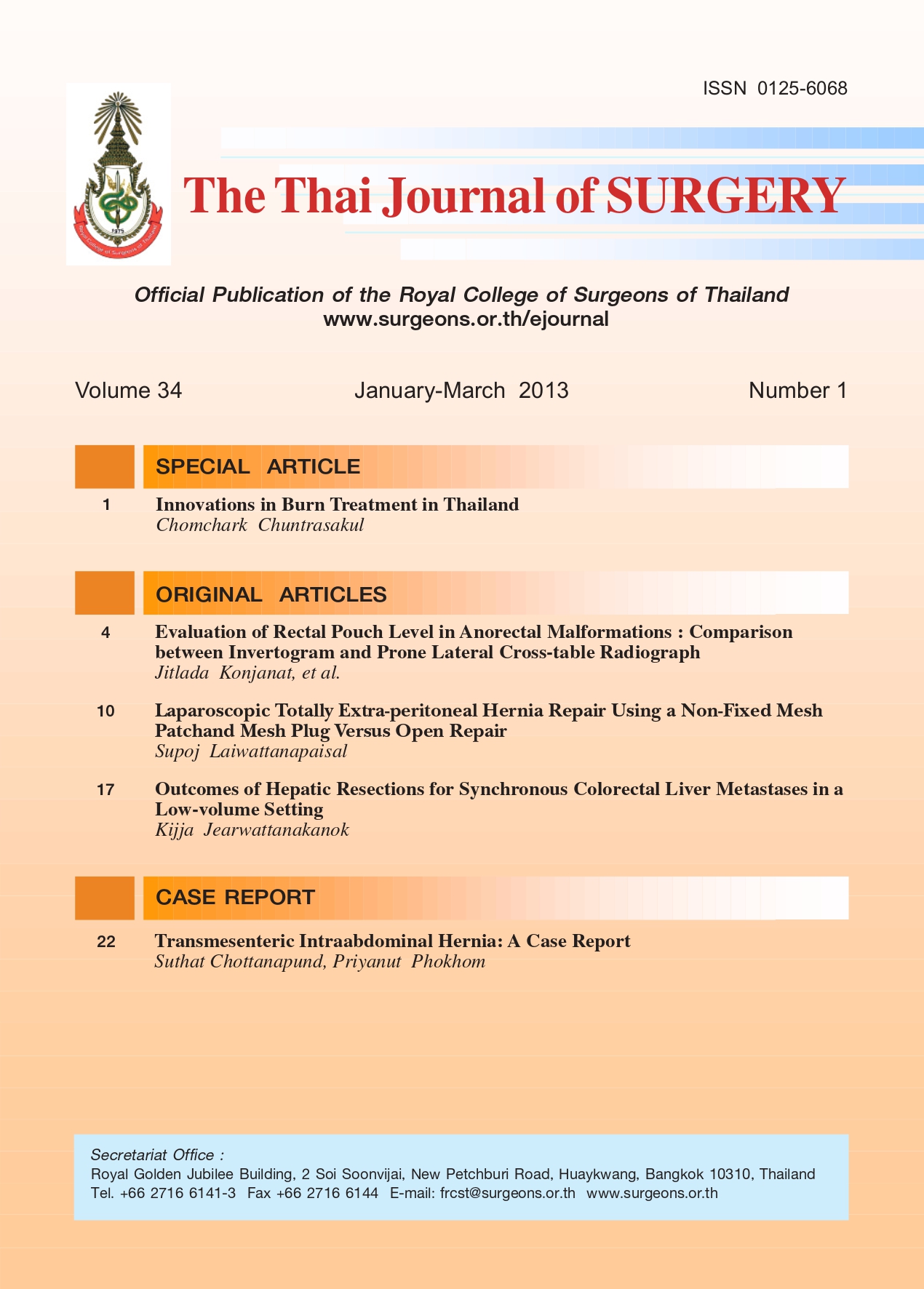Evaluation of Rectal Pouch Level in Anorectal Malformations : Comparison between Invertogram and Prone Lateral Cross-table Radiograph
Keywords:
Anorectal malformations, invertogram, prone lateral cross-table radiograph, rectal pouch levelAbstract
Background: Invertogram has been used to evaluate the level of blind rectal pouch in neonates with anorectalmalformations (ARM) for over 80 years. In recent years, prone lateral cross-table radiograph (PLCTR) has been
recommended for demonstrating these anomalies, providing equivalent information as the traditional procedure.
Objective: The aim of this study was to compare the effectiveness in evaluation of rectal pouch level in ARM
between invertogram and PLCTR.
Materials and Methods: During January 2009 to June 2012, all of the neonates with ARM who had no evidence
of cutaneous, urinary or genital fistula underwent both invertogram and PLCTR for demonstration of the blind rectal
pouches. Demographic data and radiographic findings of the patients were collected and analyzed.
Results: Fifty -two neonates with ARM (46 males and 6 females) were available for the study. Thirty-nine
patients (75%) were full term babies, whereas 13 patients (25%) were premature. Invertogram and PLCTR were done
within 13 to 36 hours after birth. Radiographic findings of the two methods in 46 patients (89%) were not different.
In the remaining 6 cases (11%), the findings of PLCTR were more accurate, with confirmation by colostomy study
(loopogram) or operative findings, while the evidence of rectal gas shadow in the invertogram revealed higher than
the actual levels.
Conclusion: PLCTR is much easier to position, less time consuming and more accurate in some cases than
invertogram regarding interpretation of the level of rectal pouch in ARM. PLCTR should be routinely used instead
of invertogram for evaluation in ARM.
References
experience. Delhi:Oxford University Press; 1991.
2. Gupta DK, Charles AR, Srinavas M. Pediatric surgery in India.
A specialty come of age. Pediatr Surg Int 2002;18:649-52.
3. Shaul DB, Harrison EA. Classification of anorectal
malformations-initial approach, diagnostic tests and
colostomy. Semin Pediatr Surg 1997;16:187-95.
4. Pena A. Current management of anorectal malformations.
Surg Clin North Am 1992;72:1393-416.
5. Templeton JM, O’ Neill JA Jr. Anorectal malformations. In:
Welch KJ, Randolph JG, Ravitch M, et al, eds. Pediatric
surgery. 2nd ed. Chicago: Year Book Medical Publishers;
1986:1022-37.
6. Chowdhary SK, Gupta A, Samujh R. Management of
anorectal malformation in neonates. Indian J Pediatr 1999;
66:791-8.
7. Pena A, Hong A. Advances in management of anorectal
malformation. Am J Surg 2000;180:377-81.
8. Holschneider AM, Pfromner W, Gerresheim B. Results in the
treatment of anorectal malformations with special regard
to the history of the rectal pouch. Eur J Pediatr Surg 1994;4:303-
9.
9. Horsirimanont S, Sangkhathat S, Utamakul P. Appraisal of
invertograms and distal colostograms in the management
of anorectal malformation. J Med Assoc Thai 2004;87:492-
502.
10. Pena A. Imperforate anus and cloacal malformations. In:
Aschcraft KW, Murphy JP, eds. Pediatric surgery. 3rd ed.
Philadelphia: WB Saunders; 2000:473-92.
11. Wangensteen OH, Rice CO. Imperforate anus: a method of
determining the surgical approach. Ann Surg 1930;92:77-81.
12. Stephens FD, Smith ED. Anorectal malformations in children.
Chicago: Year Book Medical Publishers; 1971.
13. Gordon IRS, Ross FGM. Diagnostic radiology in pediatrics.
London: Butterwortls; 1977.
14. Narasimharao KL, Prasad GR, Katariya S, et al. Prone crosstable
lateral view: an alternative to the invertogram in
imperforate anus. AJR 1983; 140: 227-9.
15. Berdon WE, Baker DH, Santulli TV, et al. The radiologic
evaluation of imperforate anus: an approach correlated
with current surgical concepts. Radiology 1968; 90: 446-71.
16. Santulli TV, Schullinge JN, Liesewette WB, et al. Imperforate
anus: a survey from the members of the surgical section of
the American Academy of Pediatrics. J Pediatr Surg 1971; 6:
484-7.
17. Pathak IC, Saifullah S. Congenital anorectal malformations
: an experience based on 50 cases. Indian J Pediatr 1969;36:
370-9.
18. Hasse W. Associated malformatons with anal and rectal
atresia. Prog Pediatr Surg 1976;9:99-103.
19. Hassink EA, Rieu PN, Hamal BC. Additional congenital defects
in anorectal malformations. Eur J Pediatr 1996;155:477-82.
20. Pena A. Anorectal malformations. Semin Pediatr Surg
1995;4:35-47.
Downloads
Published
How to Cite
Issue
Section
License
Articles must be contributed solely to The Thai Journal of Surgery and when published become the property of the Royal College of Surgeons of Thailand. The Royal College of Surgeons of Thailand reserves copyright on all published materials and such materials may not be reproduced in any form without the written permission.



